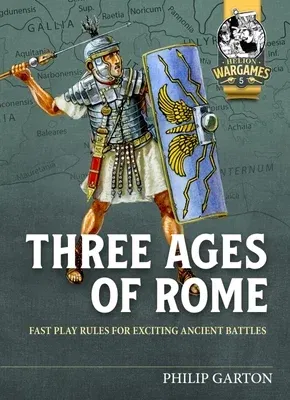No rebasing required, can be played with all current basing styles and
conventions.
For seven centuries, the history of Rome was central to the history of
Europe. This story of expansion and decline is the inspiration for these
wargames' rules.
Designed for ease of play, Three Ages of Rome offers a player
experience based on the commander's problems. The rules are designed to
create a feel for the uncertainty of ancient battles. Most games should
take 2-3 hours to play.
Keeping your men going, even when things don't seem too good, is
critical for success. Units are likely to become progressively disabled
and cohesion begins to suffer. If commanders don't take care to maintain
cohesion, then they could be heading for disaster!
The Age of Expansion (300BCE - 30BCE) starts with Rome's wars against
Carthage. Followed by Rome against Macedon, Rome against the Gallic
Celts, and several civil wars between the Romans themselves. One
struggle lasts through the period as Rome struggled to conquer the
Spanish.
In the Age of Empire (30BCE-200CE) the Romans moved north and west
conquering territories in Germania and Britain. Spreading east, they
campaigned against the Dacians and the Parthians. The Parthian kingdom
was destroyed by an internal revolt and a new dynasty, the Sassanids,
came to power. They would become the major threat to Rome's eastern
frontier. Despite its successes, the Empire was not stable. The civil
wars continued. In 69 CE there were four emperors. In 193 CE there were
five emperors! This Age ends in 200CE after Septimus Severus eliminated
the other claimants for the title.
The Age of Decline (200CE-450CE) sees Rome struggling against pressures
from outside the Empire. The wars with the Sassanids continued with
successes and included defeats for both sides. The German tribes joined
together but they were mostly repulsed. Some new enemies, the various
Gothic tribes and the Huns, pressed through the frontier. These raided
deep into Roman territory doing major damage to Roman cities, including
Rome itself. The pressure was too great and the Roman Empire broke up.
The western half would not last for long but the eastern half would rise
again as the Byzantine Empire.
The six historical battle scenarios span the Three Ages and provide
different challenges. They offer players an insight into the nature of
command in ancient warfare. The Terrain Generator and Scenario Generator
allow the players to develop their own games. For competitive games, a
system of points gives players all the information needed to exactly
balance their forces.
In battle nothing is certain but generals that practice their skills are
more likely to be victorious.

